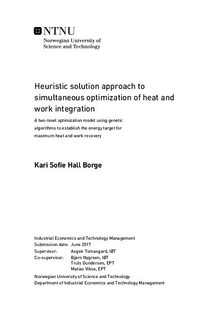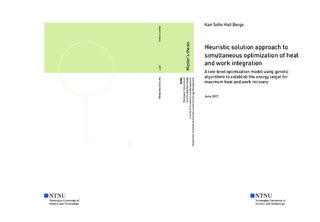| dc.description.abstract | Heat integration is of significant importance to the process industry in the efforts of reducing energy consumption and total annual costs. The heat integration problem attempts finding the optimal interconnections of processing equipment in order to reduce the energy requirements of the process. A complete model of the heat integration problem involves determining the optimal performance of the heat integrated system and the optimal design of the heat exchanger network. The performance of the system can be identified prior to the network design. This work is concerned with identifying the performance of a system in terms of an energy target for optimal heat integration.
Heat integration has long been a central topic in the process industry, however, work integration is a topic of recent interest. Both heat and work are forms of energy that are often available in industrial processes, and utilization of this energy should therefore be attempted instead of resulting in waste. For small problems, optimization of heat and work integration can be modeled with mixed-integer nonlinear programming. Introducing more than one compressing and one expanding stream, no exact solution method has currently been able to identify the energy target for optimal heat and work integration.
In order to solve the problem of simultaneous heat and work integration, a two-level optimization model using genetic algorithms has been developed. Results from solving a set of test cases with one compressing and one expanding stream, in which exact methods can prove optimality, show that the two-level optimization model is able to find the optimal or a near-optimal solution. Four new test cases are presented involving multiple compressing and expanding streams, in which the model provides high quality solutions. The model cannot guarantee a global optimal solution. However, in comparison with common practice in the industry, the two-level optimization model generates significantly better solutions.
Two genetic algorithms have been implemented and tested in this research; a basic genetic algorithm and a genetic algorithm with crowding. The algorithm with crowding was implemented in an effort to improve the global search, reducing the likelihood of getting stuck in a local optimum. Results from both algorithms are presented in comparison with common practice in the industry. | |

